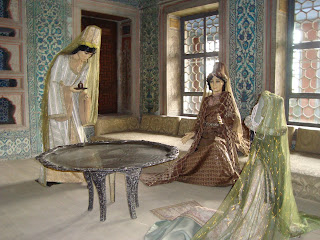 This is an engraving of Odysseus' men putting the stake into the Cyclop's eye
This is an engraving of Odysseus' men putting the stake into the Cyclop's eyeSonia, Jo, Jenny, Mikis and Alexis will remember this story, told to them when they were children by Jim, at dusk, by the olive groves in Corfu. Here's a shortened story for the new generation
Odysseus and his companions were on their way home from Troy, but their boats were blown off course and they were lost. They landed on a small island -nobody there..but they could hear people talking and see smoke on land across the water. Odysseus decided to take one boat and 12 men with him to the mainland. They took with them a goatskin full of wine and other provisions. They found a big cave; someone's home, and waited for them to return. In the evening a huge man, with only one eye (a Cyclops) came in, driving his sheep and goats before him. He rolled a big stone over the mouth of the cave, milked his animals and started to make his dinner. The men were terrified, but trapped. When the Cyclops saw them, he snatched up two of the men and ate them!
The next morning he ate two more of the men, then went out with his sheep and goats, rolling the big stone back over the cave mouth. The stone was too heavy for the men to move. It seemed they were going to all die unless they could think of a way out. Odysseus found a trunk of olive wood that the cyclops used as a walking stick. He and his men cut a p[iece off and sharpened it to a point at one end and then hardened it in the camp fire and hid it in the dung on the cave loor. When Polphemus (for that was the Cyclops name) came back that evening, he ate two more men! Then Odysseus stepped forward offered him some wine, and asked him to let them go. Polyphemus said no, he was going to eat them all, but because the wine was so good he would eat him last. He asked Odysseus his name, and he replied 'I am called 'Nobody'', and offered the giant more wine. Soon he had drunk so much that he fell into a deep sleep. Quietly, the men took out the the pointed stake, heated it up in the fire then crept up to Polyphemus and plunged it into his eye.
The cyclops leapt up and roared in pain and anger, but he couldn't catch the men. The other cyclops living in caves around heard the noise and came running to find out waht was wrong. 'Nobody has hurt me' shouted Polyphemus. 'If nobody has hurt you, we can't help you' they replied and went back to their caves to sleep. Meanwhile, Odysseus tied the sheep in pairs with a man tied under each pair and waited for the morning. At last Polyphemus rolled back the stone, and the sheep and goats trotted out. Polyphemus felt all the animals as they left the cave, but didn't think to feel underneath them. Odysseus kept back the largest billy goat and jumped up under his belly, holding tight to his wool. Polyphemus stopped him and said 'My big ram, why are you last, when usually you are the first to go out in the morning?" Odysseus thought he wasn't going to escape, but the cyclops let the ram past. Odysseus jumped down, untied all the other men, and they ran like hell for the beach, driving the flock of sheep and goats before them.
Polyphemus heard them and stumbled after the men. He tore rocks off the hill and threw them after the boat. The wash almost sent the boat back to the shore, but the men rowed as hard as they could and at last escaped. Their companions were so relieved to see them back again, but shocked to hear what had happened to the six missing men. Dividing Polyphemus' animals between them, they pushed off their boats and continued on their long journey.














